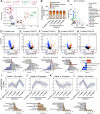Functional compartmentalization of hepatic mitochondrial subpopulations during MASH progression
- PMID: 39966593
- PMCID: PMC11836293
- DOI: 10.1038/s42003-025-07713-9
Functional compartmentalization of hepatic mitochondrial subpopulations during MASH progression
Abstract
The role of peridroplet mitochondria (PDM) in diseased liver, such as during the progression of metabolic dysfunction-associated steatohepatitis (MASH), remains unknown. We isolated hepatic cytoplasmic mitochondria (CM) and PDM from a mouse model of diet-induced MASLD/MASH to characterize their functions from simple steatosis to advanced MASH, using chow-fed mice as controls. Our findings show an inverse relationship between hepatic CM and PDM levels from healthy to steatosis to advanced MASH. Proteomics analysis revealed these two mitochondrial populations are compositionally and functionally distinct. We found that hepatic PDM are more bioenergetically active than CM, with higher pyruvate oxidation capacity in both healthy and diseased liver. Higher respiration capacity of PDM was associated with elevated OXPHOS protein complexes and increased TCA cycle flux. In contrast, CM showed higher fatty acid oxidation capacity with MASH progression. Transmission electron microscopy revealed larger and elongated mitochondria during healthy and early steatosis, which appeared small and fragmented during MASH progression. These changes coincided with higher MFN2 protein levels in hepatic PDM and higher DRP1 protein levels in hepatic CM. These findings highlight the distinct roles of hepatic CM and PDM in MASLD progression towards MASH.
© 2025. The Author(s).
Conflict of interest statement
Competing interests: K.C.K., and U.M. have a patent pending for the method described herein. All other authors declare no conflict of interests.
Figures






References
-
- Eslam, M., Sanyal, A. J., George, J. & International Consensus, P. MAFLD: A Consensus-Driven Proposed Nomenclature for Metabolic Associated Fatty Liver Disease. Gastroenterology158, 1999–2014.e1991 (2020). - PubMed
-
- Adams, L. A. et al. The natural history of nonalcoholic fatty liver disease: a population-based cohort study. Gastroenterology129, 113–121 (2005). - PubMed
-
- Browning, J. D. et al. Prevalence of hepatic steatosis in an urban population in the United States: impact of ethnicity. Hepatology40, 1387–1395 (2004). - PubMed
-
- Kopec, K. L. & Burns, D. Nonalcoholic fatty liver disease: a review of the spectrum of disease, diagnosis, and therapy. Nutr. Clin. Pr.26, 565–576 (2011). - PubMed
MeSH terms
Grants and funding
- R01HL167670/U.S. Department of Health & Human Services | NIH | National Heart, Lung, and Blood Institute (NHLBI)
- R00DK120875/U.S. Department of Health & Human Services | NIH | National Institute of Diabetes and Digestive and Kidney Diseases (National Institute of Diabetes & Digestive & Kidney Diseases)
- P30 DK078392/DK/NIDDK NIH HHS/United States
- P30DK078392/U.S. Department of Health & Human Services | NIH | National Institute of Diabetes and Digestive and Kidney Diseases (National Institute of Diabetes & Digestive & Kidney Diseases)
- R01 HL167670/HL/NHLBI NIH HHS/United States
LinkOut - more resources
Full Text Sources
Medical
Miscellaneous

